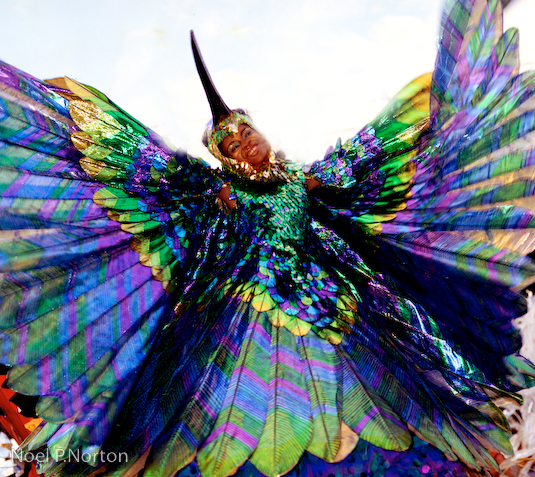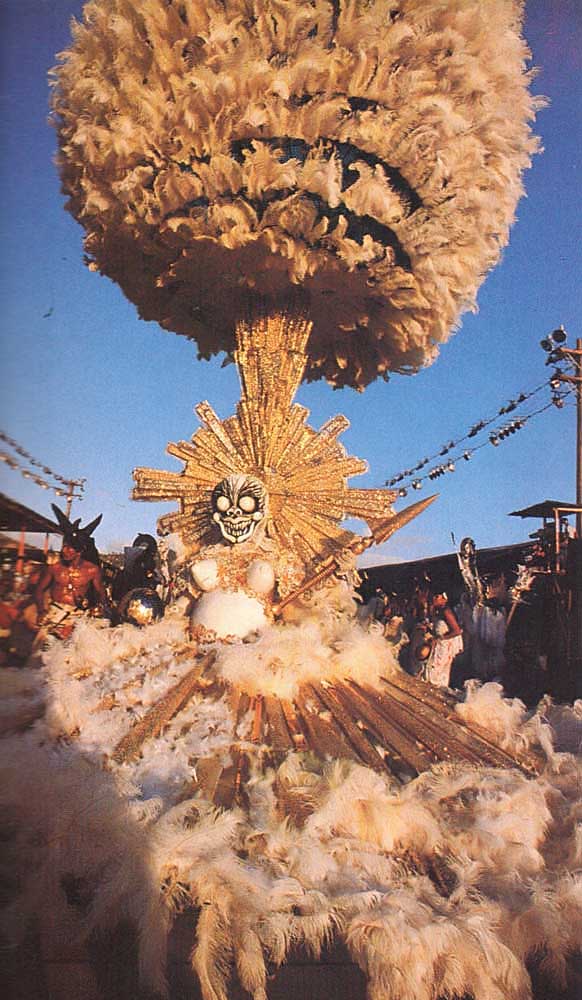The work of Peter Minshall
This essay will deal with the role and importance of characters and storylines in Trinidad and Tobago Carnival and more specifically, in the work of Peter Minshall. In order to define the work of Peter Minshall, we must first define Carnival. Carnival comes from the Latin Carnis- Flesh and Vale- farewell.[1] Therefore Carnival literally translates to the ‘farewell to the flesh’ period prior to lent. Throughout the history of Carnival, the use of characters to portray different things has been the norm. From the Negue Jardin to the Midnight Robber, and the Pierrot Grenade to the Jab Molassi, the characters are varied and diverse. The work of Peter Minshall is world-renowned and is the epitome of Trinidad and Tobago Mas’ (abbreviated form of masquerade), so much so that he is colloquially known in Trinidad and Tobago as “Mas Man”.[2]
This paper seeks to explore the role and importance of characters in Trinidad and Tobago Carnival through the work of Peter Minshall. Minshall is known for taking the art of Carnival design into choreography and telling stories through his work. Amongst all the carnival artists, it is Minshall who first started breaking boundaries in his work as we will see in his trilogy of bands between 1983 and 1985.
From a very young age he began taking part in Carnival and it was the stories of the characters and what they represented that struck a cord with Minshall. He was riveted with the stories his father told him of the characters and the design of the characters, and how when they moved, the cloth used to make the costume danced, and through this dance, they spoke to him.[3] As a child in the Caribbean, and more specifically Trinidad and Tobago, being around the creativity and experience of Carnival would have influenced the art of Minshall. At the age of 12 he came to Trinidad with his family from British Guiana, and just one year later at the age of 13 he made his first Carnival costume. Throughout his teenage years he started making costumes for friends and family, and at the age of 21, he went to study theatre and performance arts at the Central School of Art and Design in London. In fact, his thesis paper was on the Carnival Character of the Bat; a character that intrigued him and even served as inspiration in his later works.[4]
Carnival has its origins as “Canboulay” (French- Cannes Brulees – Cane Burning) when in the 1800’s, the slaves and indentured laborers were not permitted to take part in Carnival, and they created their own procession.
The dissident slaves would signal their comrades with a hillside fire to burn the cane fields. The Negue Jardin who were field slaves from neighboring estates were the ones in charge of extinguishing the fires. This was eventually reenacted as a street performance annually, and was later joined by the upper class French- Creoles, who, in their torn pants and sooty face, parodied the Negue Jardin. The Canboulay planted the seeds for what is now Carnival in Trinidad and Tobago as there were masquerades, characters, and the early signs of an endemic music from Trinidad and Tobago, including the steel pan.[5]
By the 1940’s the Canboulay was replaced by the Dimanche Gras on Carnival Sunday with the first Dimanche Gras taking place in 1948. This was when the King and Queen of Carnival were crowned and it began as a way to create a theatrical experience out of the mas or carnival.[6] Of course it wasn’t until 26 years later in 1974 that Minshall’s debut into the this competition would take place, with his band “Land of the Hummingbird,” but it is important to note the history in order to better understand his thinking, and his work.[7]
His first Carnival Band “Land of the Hummingbird” was, to Minshall, everything he sought to embody through his Carnival designs. It was a character where the cloth was dancing.
According to Minshall, “At first she looked like nothing, just a little blue and turquoise triangle, bobbing along among those grand plumed and glittering chariots, a little tent bobbing along. And then, the hummingbird burst into life, like a sapphire exploding.”7 He sought, through this costume to make the hummingbird not someone in a hummingbird costume, but a hummingbird itself. The costume wearer became the character and performed a narrative based on that. Throughout the years and in his work that came after Land of the Hummingbird, Minshall’s work began to take on new heights as he sought to find a deeper meaning within his work. He did this by looking at world-wide issues such as environmental problems, homophobia, and other such things in his works, rather than just have his carnival bands be purely about revelry.
Nothing fits this new meaning better than Minshall’s trilogy of bands that he put out between the years 1983-1985. These bands were the epitome of the character usage that Minshall did so well, in 1983, the first band was “River,” followed by “Callaloo” in 1984, and finalized with “The Golden Calabash” in 1985. In 1983,the first band of this trilogy “River” was created. It featured Mancrab as the king and Washerwoman as the queen.[8]
The construction of the king, Mancrab, was quite exquisite. Based on a crab, the costume had six arms that resemble pincers and were able to be moved as if dancing. There were two poles attached to each foot, that were 16 feet in height and attached to a 25-foot square canopy of white silk. The mask was papier-mache and was made to reflect the contours of the human face. Everything from the music played (East Indian- derived Tassa Drums) when the king crossed the stage, to the actions of the dance, were coordinated into a form of theatre never before seen in Trinidad carnival.[9] Washerwoman was the beautiful Queen of Mancrab. She wore a long white skirt, and she had two poles attached to her shoulders where clothes were hung from a clothesline. She also carried a wash basket, which reflected the washing of clothes.
The story of Mancrab and Washerwoman was called “Crab and de Callaloo,” which was derived from a Trinidadian folktale. “Mancrab was jealous of the powers of this beautiful queen, who protected her river people from the crab’s pollution and greed. Through the course of Carnival, the Mancrab was determined to capture the admiration of the river people by offering them technology. Jealous of the power of love symbolized by a magical calabash filled with pure water, which was controlled by the queen, Mancrab planned to destroy that protective love. With slick black oils and beautiful chemicals that composed a rainbow, this villain painted the river. The colors stood for the luxury and profits brought by the technology. The river people were attracted to the promised wealth and fought with one another to fill their basins with the colored water. This turning away from purity by the people broke the heart of the queen, causing her death.”9
The following year with “Callaloo,” the costume was, according to Minshall, “an unprecedented conjunction of celebration and dance.”[10] The importance of story line and character in Minshall’s work at this time were very important. Callaloo is defined as “A thick green soup made from dasheen leaves, ochroes, coconut milk, seasoned to taste. Invariably includes crab. Pot- Pourri. Blending of unlikely elements.”[11] For this piece of the trilogy, the main characters included King Callaloo who was the son of Washerwoman, the Mancrab, the Bird of Paradise as queen symbolized peace and harmony and represented the spirit of Washerwoman, and an individual called Madame Hiroshima who was a creation of Mancrab’s technology. King Callaloo represented the every race of the very diverse Trinidad and Tobago; African, European, Chinese, Indian, mixed. It represented every color, creed, race, and culture.[12]
In the finale of the trilogy entitled “The Golden Calabash” in 1985, the concept of good versus evil was explored by Minshall. This was presented as a clash of two bands, the “Lords of the Light “ and the “Princes of Darkness.”12 The battle of these two bands would determine who won the prized Golden Callabash, however it ended inconclusively before an awestruck audience at the Queens Park Savannah.
Historically in Carnival, the characters could be divided into either good or bad, light or dark. Characters such as Clowns, Pierrot Grenades, Fancy Sailors and Dame Lorraines can be considered as the light characters with the dark characters including the Bat, the Midnight Robber, Jab Molassi, and Blue devils. Throughout his career as a Mas Man, Minshall explored both good and bad characters in his bands, and this can be seen clearly in the River trilogy where both good and bad characters are portrayed.[13]
Peter Minshall’s trilogy was perhaps before its time in terms of Trinidad and Tobago Carnival as it failed to win any official titles, but it did win the people’s choice award, which was decided by ordinary spectators.[14] The river trilogy was, in a time when Carnival was being described as a form of mindless and immoral behavior, a type of masquerade that attained a sublime in its art form. Minshall’s artistic ambitions were not recognized this time, however, it opened opportunities for him such as being commissioned to create the opening presentation of the Pan-American Games in Indianapolis in 1987, and of course the 1992 Barcelona Olympics , 1996 Atlanta Olympics, 1994 FIFA World Cup, and the 2002 Salt Lake City Winter Olympics for which he won an Emmy Award for Outstanding Costumes for a Variety or Music Program.[15]
Throughout his career, Minshall has stayed true to the core meaning of Trinidad and Tobago Carnival. He has used characters and storylines and made them into yearly productions of Mas. His work defines the meaning of Carnival production in that he doesn’t simply create a Carnival Band; he creates a production of color, costume, sculpture, and music, where the participants also serve as the performers and the characters in his story.
[1] Mendes, John, “Cote ci Cote la, Trinidad & Tobago Dictionary,” (Port-of-Spain, Medianet Ltd, 1986.)
[2] Narine, Dalton, “Mas Man- The Complete Work,” DVD (King Carnival Productions, 2012.)
[3] Ganase, Pat, “Lord of the Dance: Peter Minshall,” (Caribbean Beat Magazine, September/ October 1992.)
[4] Laughlin, Nicholas, “Masman: Peter Minshall,” (Caribbean Beat Magazine, May/ June 2006.)
[5] Mendes, John, “Cote ci Cote la, Trinidad & Tobago Dictionary,” (Port-of-Spain, Medianet Ltd, 1986.)
[6] Trinidad & Tobago National Library and Information System Authority, “Mama Dis is Mas” Accessed October 31st, 2012 http://www2.nalis.gov.tt/Research/SubjectGuide/Carnival/tabid/105/Default.aspx?PageContentMode=1
[7] Ganase, Pat, “Lord of the Dance: Peter Minshall,” (Caribbean Beat Magazine, September/ October 1992.)
[8] Nunley, John, “Peter Minshall- The Good, the Bad, and the Old in Trinidad Carnival,” Imagery & Creativity: Ethnoaesthetcics and Art Worlds in the Americas/ edited by Whitten, Dorothy S. and Whitten, Norman E. (The University of Arizona Press, 1993), 289-307.
[9] Nunley, John, “Peter Minshall- The Good, the Bad, and the Old in Trinidad Carnival,” Imagery & Creativity: Ethnoaesthetcics and Art Worlds in the Americas/ edited by Whitten, Dorothy S. and Whitten, Norman E. (The University of Arizona Press, 1993), 289-307.
[10] Ganase, Pat, “Lord of the Dance: Peter Minshall,” (Caribbean Beat Magazine, September/ October 1992.)
[11] Mendes, John, “Cote ci Cote la, Trinidad & Tobago Dictionary,” (Port-of-Spain, Medianet Ltd, 1986.)
[12] Nunley, John, “Peter Minshall- The Good, the Bad, and the Old in Trinidad Carnival,” Imagery & Creativity: Ethnoaesthetcics and Art Worlds in the Americas/ edited by Whitten, Dorothy S. and Whitten, Norman E. (The University of Arizona Press, 1993), 289-307.
[13] Nunley, John, “Peter Minshall- The Good, the Bad, and the Old in Trinidad Carnival,” Imagery & Creativity: Ethnoaesthetcics and Art Worlds in the Americas/ edited by Whitten, Dorothy S. and Whitten, Norman E. (The University of Arizona Press, 1993), 289-307.
[14] Laughlin, Nicholas, “Masman: Peter Minshall,” (Caribbean Beat Magazine, May/ June 2006.)
[15] Narine, Dalton, “Mas Man- The Complete Work,” DVD (King Carnival Productions, 2012.)





